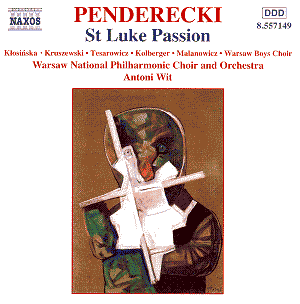Naxos have recently
been making a speciality of excellent
new recordings of modern choral masterpieces.
Alsop’s Chichester
Psalms is a striking example,
as was before that Tonus Peregrinus’
version of Pärt’s St.
John Passion (which, as I am
one of the soloists, modesty should
prevent me mentioning, but sadly hasn’t
done!). Now we have a magnificent new
version of Penderecki’s great St.Luke
Passion of 1962. This is a particularly
timely issue; the work has had a number
of recordings, but they have all proved
less than entirely satisfactory.
And it is a masterpiece;
Penderecki employs much the same forces
as are to be found in the Bach Passions
– large chorus, often sub-divided, orchestra
and soloists – but subjects them to
the full range of avant garde usage.
The choir hiss, giggle, whistle, even
sing sometimes, and their music is full
of glissandi and complex dissonant clusters,
while the members the huge orchestra
are often asked to play in free improvisatory
style. Penderecki’s Evangelist declaims
his text (which is in Latin all the
way through, the composer sensibly favouring
this religious lingua franca over
his native Polish), and Krzystof Kolberger
injects just the right amount of drama
and emotion into his delivery, varying
the pace with great skill. The other
soloists are superb, too; Izabella Klosinska
has a typical Polish soprano voice –
rich and powerful in its lower range,
ringingly dramatic at the top. She projects
her part with great feeling, and is
outstanding in the near hysteria of,
for example, her ‘Domine’ solo (track
4). She also has the measure of these
very difficult notes, and sings with
stunning accuracy, which sets her apart
from, for example, Sigune von Osten
on the composer’s own Argo recording.
Klosinska’s Crux fidelis (track
18 in Part II), her incisive and intense
tone contrasting with the hollow sound
of the alto flute, is one of the supreme
moments in the whole performance. Adam
Kruszewski sings with beautiful simplicity
in the role of Christ, and Romuald Tesarowicz
is a commanding and affecting bass.
The Warsaw choir is
simply exceptional; they pull off all
the choral ‘special effects’ with confidence
and aplomb, and manage to produce tone
of great beauty when appropriate, for
example in the extended Stabat Mater
section which occupies a crucial
place in Part II. The ‘crowd’ choruses
are spine-chilling, the recording allowing
one to hear all the layers of detail
while maintaining an honest sense of
perspective. Very often, these outbursts
of violence are followed by quiet, nearly
immobile contemplative choruses, such
as ‘Ierusalem’ on track 6 in Part I.
How uniquely this work emphasises the
shame, the trauma of the Easter story.
Yet that shame must
be balanced by hope, if the message
is not to be traduced. The most talked-about
aspect of the work are the two colossal
major chords which come out of nowhere
– one at the end of the Stabat Mater,
echoed by another, this time backed
up by the full orchestra, at the end
of the whole work. These are truly shocking,
and it’s hard to describe their effect;
the nearest I can get is to say that
it resembles groping round in the dark
for some hours, only to be suddenly
bathed in the most intense sunlight
without warning – disconcerting, but
unforgettable!
Conductor Antoni Wit
paces the whole work with consummate
skill, and draws very fine playing from
the Warsaw Philharmonic all the way
through, and especially in passages
such as their deeply expressive introduction
to the final chorus. At such moments,
Penderecki edges away from the avant
garde, and proclaims his spiritual kinship
with the greatest Eastern European artist
of that time, Dmitri Shostakovich.
I could go on for some
time about the many, many stunning and
revelatory moments in this performance;
but I won’t, you’ll be glad to know!
This is a ‘must hear’, though, and a
‘must buy’ too, especially at this ridiculous
price. The recording captures everything
breathtakingly well, from the lightest
choral whisper to the great slashes
of organ sound that erupt in the big
choruses; from the ethereal clusters
of string harmonics to the explosive
grunting of contrabassoon. There’s no
doubt that the recording benefits from
being made in a modern concert hall
(Warsaw Philharmonic Hall) rather than
in the cavernous depths of Katowice
Cathedral, as with the Argo CD. It has
to be said – Naxos have done it again!
They deserve our thanks and congratulations
for this fully realised version of a
great modern masterpiece.
Gwyn Parry-Jones
